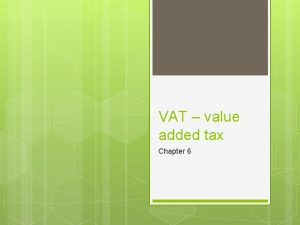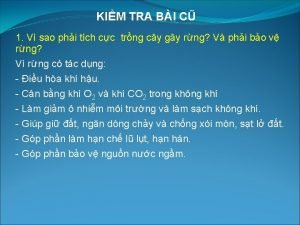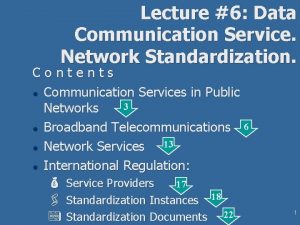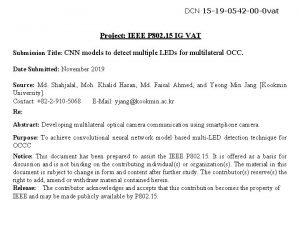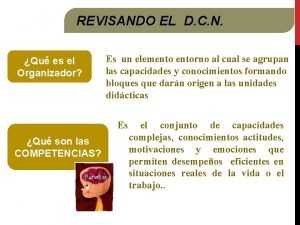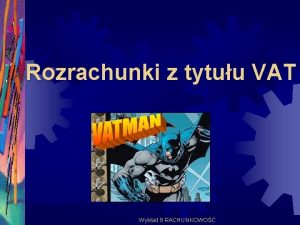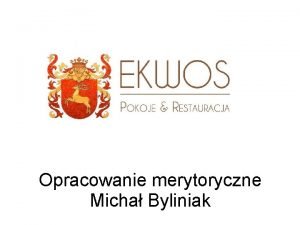DCN 15 19 0542 00 0 vat Project


![DCN 15 -19 -0542 -00 -0 vat Object detection techniques q Faster R-CNN [1] DCN 15 -19 -0542 -00 -0 vat Object detection techniques q Faster R-CNN [1]](https://slidetodoc.com/presentation_image_h/fc8d29b699d4ed081f4ea24d1b3afb8b/image-3.jpg)

![DCN 15 -19 -0542 -00 -0 vat Object detection techniques q YOLOv 3 [5] DCN 15 -19 -0542 -00 -0 vat Object detection techniques q YOLOv 3 [5]](https://slidetodoc.com/presentation_image_h/fc8d29b699d4ed081f4ea24d1b3afb8b/image-5.jpg)




- Slides: 9

DCN 15 -19 -0542 -00 -0 vat Project: IEEE P 802. 15 IG VAT Submission Title: CNN models to detect multiple LEDs for multilateral OCC. Date Submitted: November 2019 Source: Md. Shahjalal, Moh. Khalid Hasan, Md. Faisal Ahmed, and Yeong Min Jang [Kookmin University]. Contact: +82 -2 -910 -5068 E-Mail: yjang@kookmin. ac. kr Re: Abstract: Developing multilateral optical camera communication using smartphone camera. Purpose: To achieve convolutional neural network model based multi-LED detection technique for OCCC Notice: This document has been prepared to assist the IEEE P 802. 15. It is offered as a basis for discussion and is not binding on the contributing individual(s) or organization(s). The material in this document is subject to change in form and content after further study. The contributor(s) reserve(s) the right to add, amend or withdraw material contained herein. Release: The contributor acknowledges and accepts that this contribution becomes the property of IEEE and may be made publicly available by P 802. 15.

DCN 15 -19 -0542 -00 -0 vat Introduction • Computer vision tasks include methods for acquiring, processing, analyzing and understanding digital images, and extraction of highdimensional data from the real world. • Real-time computer vision can be performed using open source computer vision (Open. CV) programming library. Open. CV has vast application areas such as facial recognition system, human-computer interaction, object identification, mobile robotics, motion tracking, augmented reality. • A brief overview of the DNN based object detection techniques has been provided. These are computationally complex and requires high performance GPUs.
![DCN 15 19 0542 00 0 vat Object detection techniques q Faster RCNN 1 DCN 15 -19 -0542 -00 -0 vat Object detection techniques q Faster R-CNN [1]](https://slidetodoc.com/presentation_image_h/fc8d29b699d4ed081f4ea24d1b3afb8b/image-3.jpg)
DCN 15 -19 -0542 -00 -0 vat Object detection techniques q Faster R-CNN [1] is the third version of R-CNN where R stands for region. The previous two versions (R-CNN & Fast R-CNN) uses selective search which is much slow and time-consuming process affecting the performance of the network. Whereas, Faster RCNN uses region proposal networks (RPN) to predict where an object lies. The predicted region proposals are then reshaped using a region-of-interest (Ro. I) pooling layer which is then used to classify the image within the proposed region and predict the offset values for the bounding boxes q Mask R-CNN [2] is the extension of Faster RCNN method in which a segmentation mask is added on each Ro. I along with the bounding boxes. This additional segments facilities the wide use cases. The inference time requires for Mask R-CNN is within 350 -200 ms.

DCN 15 -19 -0542 -00 -0 vat Object detection techniques
![DCN 15 19 0542 00 0 vat Object detection techniques q YOLOv 3 5 DCN 15 -19 -0542 -00 -0 vat Object detection techniques q YOLOv 3 [5]](https://slidetodoc.com/presentation_image_h/fc8d29b699d4ed081f4ea24d1b3afb8b/image-5.jpg)
DCN 15 -19 -0542 -00 -0 vat Object detection techniques q YOLOv 3 [5] is a completely different way of object detection where it passes the whole image only once same as SSD. In this process the image is divided into a grid of cells which depends on the size of the input image. Each cell is responsible for predicting the number of boxes in the image. Then confidence of prediction is made for each boxes and boxes of lower values are eliminated by using non-maximum suppression technique. q SPP-net Spatial Pyramid Pooling network (SPP-net) [3] can generate a fixed-length representation regardless of image size/scale. In this system the feature maps of convolution layer are feed into a spatial pyramid pooling layer and it finally represent fixed length outputs to fully-connected layers. Average time of 100 random VOC images using GPU for SPP-net 5 - scale version is about 382 ms.

DCN 15 -19 -0542 -00 -0 vat Object detection techniques q SSD Single-shot multi-box detector (SSD) is a simple and faster than you only look once (YOLO) even more accurate. This feature eliminates proposal generation and resampling stages and encapsulates in a single detector which makes it simple for training and inference. In [4] shows 74. 3% m. AP for 300 -by- 300 input on VOC 2007 test at 59 fps. q FPN In feature pyramid networks (FPN) a single-scale image of an arbitrary size is used as input and proportionally sized feature maps are taken as outputs. This method introduces small extra cost by the extra layers in the FPN, but has a lighter weight head FPN is proposed in [6] and they test the performance on RPN and Fast RCNN. They achieved 0. 165 s inference time per image for FPNbased Fast R-CNN on NVIDIA M 40 GPU for Res. Net-50.

DCN 15 -19 -0542 -00 -0 vat Tensorflow Lite for smartphones

DCN 15 -19 -0542 -00 -0 vat Tensorflow Lite for smartphones ü This is a lightweight framework of Tensor. Flow for mobile and embedded devices. It has low latency and small binary size to develop DNN on Android or i. OS. ü Android 8. 1 or API level 27 and higher associates with Android neural network API for hardware acceleration. Whereas this API is supported by the Tensor. Flow Lite. ü The trained model for Tensor. Flow Lite can be built in Mobile. Nets which are a class of CNN designed by google. Tensor. Flow Lite can use those pre-trained models on Mobile. Nets to perform several selective tasks such as object detection face attributes detection, fine-grain classification, and landmark recognition.

DCN 15 -19 -0542 -00 -0 vat References
